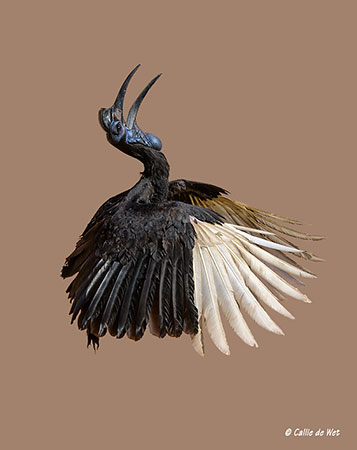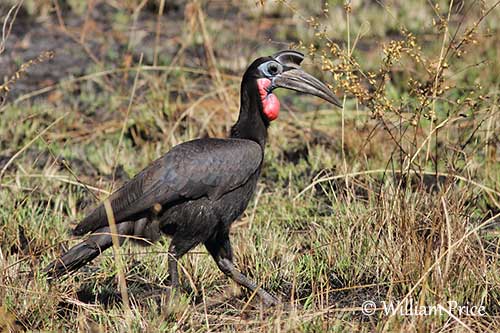
Fr: Bucorve d’Abyssinie
Ang: Northern Ground-hornbill – Abyssinian Ground-hornbill
All: Sudanhornrabe
Esp: Cálao Terrestre Norteño
Ita: Bucorvo abissino
Nd: Noordelijke Hoornraaf
Sd: Nordlig markhornkorp
Photographers:
Ken Havard
My Bird Gallery & Flickr gallery 1 & Flickr gallery 2
William Price
PBase-tereksandpiper & Flickr William Price
Callie de Wet
GALLERY
Text by Nicole Bouglouan
Sources:
HANDBOOK OF THE BIRDS OF THE WORLD Vol 6 by Josep del Hoyo-Andrew Elliott-Jordi Sargatal - Lynx Edicions, 2001 - ISBN: 848733430X
BIRDS OF AFRICA SOUTH OF THE SAHARA by Ian Sinclair and Peter Ryan - Princeton University Press Princeton and Oxford - ISBN: 0691118159
BIRDS OF THE GAMBIA AND SENEGAL by Clive Barlow and Tim Wacher – Helm Field guides – ISBN: 0713675497
BirdLife International (BirdLife International)
Animal Diversity Web (University of Michigan Museum of Zoology)
Welcome to the Mabula Ground-Hornbill Project
Smithsonian National Zoological Park
Northern Ground-hornbill or Abyssinian Ground-hornbill
Bucorvus abyssinicus
Bucerotiformes Order – Bucorvidae Family
INTRODUCTION:
The Northern Ground-hornbill is the second member of the family Bucorvidae which gathers the two largest species of hornbills. They are terrestrial birds but they can fly and often perch in trees for roosting. They are mainly carnivorous, and they rarely consume plant matter.
Several African legends talk about the Northern Ground-hornbill, but depending on regions and villages, it may bring good luck, but bad luck too.
DESCRIPTION OF THE BIRD:
Biometrics:
Length: 90-100 cm
Weight: M: 4000 g
The adult male has black plumage overall, except the white primaries.
On the black head, the eyes are surrounded by bare blue skin. The inflatable throat skin is blue and red.
The large, down-curved bill is black with yellow/orange patch at base of the upper mandible. The high casque is black too. It is placed at the upper base of the bill. We can see two ridges along each side, and an opening at the end of the casque.
The eyes are dark brown with long eyelashes that are modified feathers. Strong legs and feet are black.

The female has similar plumage overall and only differs from the male by the colour of the throat skin which is entirely blue.
The juvenile is browner than adults, and the primaries are flecked black. The casque is lacking too, and it has dull yellow patch on the bill. The bare face is mainly pale grey. It is sexually mature at 3-4 years old.
RANGE:
The Northern Ground-hornbill occurs from S Mauritania and Guinea, E to Ethiopia and NW Somalia, NE Kenya and Uganda.
HABITAT:
The Northern Ground-hornbill occurs in savannas, open grasslands, sparse woodlands, forest edges, rocky areas with short vegetation for better foraging. It is usually present in drier areas than the Southern Ground-hornbill. It can be seen up to 3200 metres of elevation in Ethiopia. It needs areas with large trees for roosting and nesting.
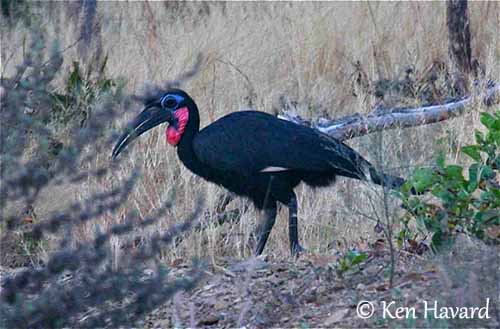
CALLS AND SONGS: SOUNDS BY XENO-CANTO
The Northern Ground-hornbill utters a loud call, a deep, booming sound and grunting too, thanks to the inflation of the throat skin “umm-hum-umm” or “uuh-uh-uh” delivered from prominent perch.
It usually calls mostly before dawn, and the low-frequency sounds can be heard through the savannas.
BEHAVIOUR IN THE WILD:
The Northern Ground-hornbill is mainly carnivorous and feeds on reptiles, tortoises, lizards, but also mammals (hares) and mongooses. It also takes arthropods, various insects and spiders. Carrion is taken sometimes, but only to supplement live prey.
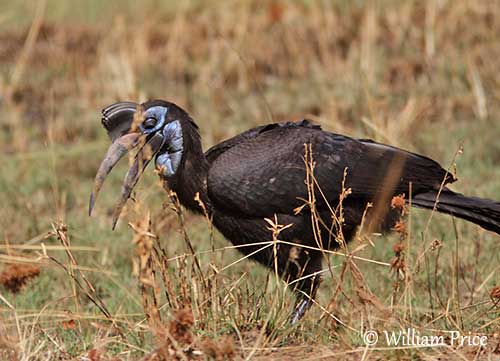
The Northern Ground-hornbill often follows groups of ungulates to take advantage of the disturbed preys, and it is also present at forest fires where it can catch fleeing animals. It may walk up to 10-12 km per day while foraging and feeding on preys found in its path and grabbed with the bill.
But the large bill is also used for digging for invertebrates, and it also consumes honeycomb, but rarely plant matter.
The Northern Ground-hornbill is mainly terrestrial, but it can fly too, as well to catch a prey as in territory defence. They are often seen in pairs or in small family groups, because the young remain in their native territory for several years. They roost in groups in large trees to avoid predation.
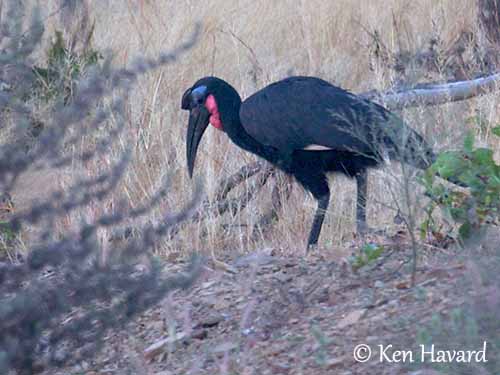
The Northern Ground-hornbill is monogamous and usually mates for life. They nest in cavities but the entrance is not completely closed like in other hornbills.
During the breeding season, the bare skin of face and throat becomes brighter. While incubating, the female depends on her mate for food.
The Northern Ground-hornbill is sedentary in its range, but the species may wander S in Kenya where it overlaps with the Southern Ground-hornbill.
This species rarely flies and usually prefers to run or walk. But if threatened, it can fly up into trees if forced.
In flight, the white primaries contrasting with the black plumage are conspicuous.
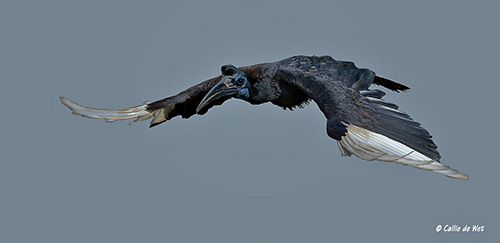
REPRODUCTION OF THIS SPECIES:
The breeding season varies with the range, between June and August in W Africa, in January in Nigeria and Uganda, and in November in Kenya.
The nest is placed in tree cavity, often baobab or palm stump. It may be sometimes in rock hole or artificial cavities, but only occasionally.
The cavity is lined with dry leaves brought by the male. The entrance is partially sealed with a mixture of plants and mud.
The female lays 1-2 eggs over 4-5 days. The incubation lasts 37-41 days. The male feeds the female through the entrance, but the nest is not cleaned. The first-hatched chick grows rapidly, involving the death of the second chick by starvation.
The female leaves the nest after 21-33 days, and both parents feed the chick which fledges 80-90 days after hatching. It still depends on adults for food for several months.
PROTECTION / THREATS / STATUS:
The Northern Ground-hornbill might be affected in the future by the destruction of suitable nesting trees. It is still hunted for food in some parts of the range and for African folklore.
This species has large range where the main pressure is habitat loss. However, the Northern Ground-hornbill is currently evaluated as Least Concern and has stable populations.
